|
1.
CENTRAL/ WEST AFRICA
Markets quiet due to European holiday period
During the first half of August, no price changes in logs or lumber were recorded. For logs, however,
there was a small sign of recovery in purchases from Chinese buyers. Ships are now waiting to be
fully loaded and, although this is not a sure sign of revival in market demand, it marks a
move toward resumption of normal trading conditions. The new quota restrictions on log exports in Gabon
and Congo Brazzaville have assisted greatly in keeping log prices relatively stable over the last few
months and the minor improvements in the market due to Chinese buying patterns should help
reinforce market stability.
Negotiations on quota volumes for producers are continuing, though it is understood those issued
so far are not yet being applied to log exporters. It appears that the total amount of exports had
been reduced while still allowing for sufficient volume to keep processing mills
fully supplied and a moderate level of logs ready for export.
The European market was very quiet with virtually no buying activity due to the vacation period. At
the end of this period, it is likely that industry will be carefully watching the global markets before
making new commitments.
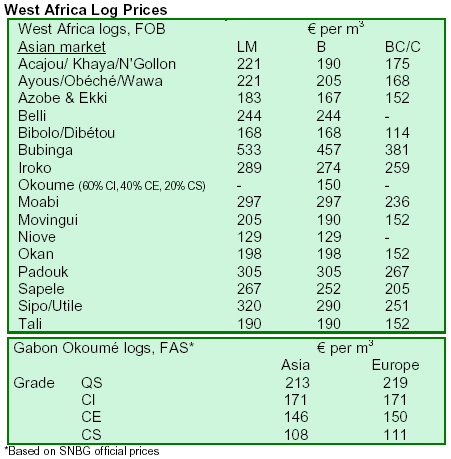
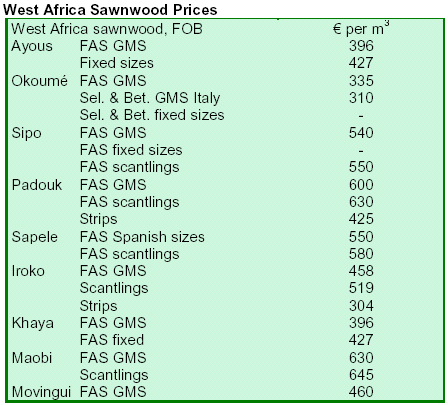
2. GHANA
New benefit sharing scheme for plantation timber
The Cabinet has approved a new benefit sharing scheme on these plantations, under which 40% of
the produce obtained from the plantation areas would be allocated to the Forestry Commission
(FC), 40% to farmers, 15% to andowners, and 5% to the local community. Since July
2001, Ghana has established about 43,000 hectares under the President¡¯s plantation development initiative. Over
46,000 full-time workers and approximately 1.1 million part-time workers have planted about
170,000 hectares of trees nationwide.
The announcement about the new benefit sharing scheme was made by Mr. Ahmed Bin
Salih, Chief
Director, on behalf of Prof. Dominic Fobih, former Minister of Lands, Forestry and Mines at the
opening of the Seventh Quadrennial Delegates Conference of the Timber and Woodworkers Union
(TWU) in Cape Coast. He noted that the Cabinet was also considering a reviewed benefitsharing
scheme for parties engaged in commercial plantation development in degraded forest reserves to
ensure equity returns to investors as a means of facilitating speedy development of commercial
plantations in the country. He also noted that the programme had made available fertile and
productive agricultural lands within degraded forest reserves for farmers to boost food
production and ensure food security.
Mr. Ahmed further noted that community participation in forest resource management and
protection was also being enhanced through various alternative livelihood schemes
instituted through projects that benefited over 1,000 people within forest fringe communities, noting that more
than US$2.3 million had been disbursed to individuals in beneficiary communities for this purpose.
He said the depletion of forest resources could not be reversed without the active participation of
important stakeholders such as landowners, communities and other organizations within
the timber trade.
Lessons learned by Ghana from benefit sharing schemes were in part due to previous experiences
with afforestation projects. Mr. Joshua Ansah, General Secretary of TWU explained that 75 of the
240 hectares of land from chiefs and elders of Techiman at Kokoago set aside for an
afforestation project ten years ago had been cultivated with various tree species. He said the project was
implemented in partnership with the local community and the members enjoyed livelihood support
activities such as beekeeping, mushrooms, fish, snail farming, and seasonal employment on the
plantation. Ansah noted that the project was recently designated by the Building and
Woodworkers International as the most sustainably managed project in the African union and recommended
its model be replicated in Mali, Burkina Faso, Kenya and Uganda.
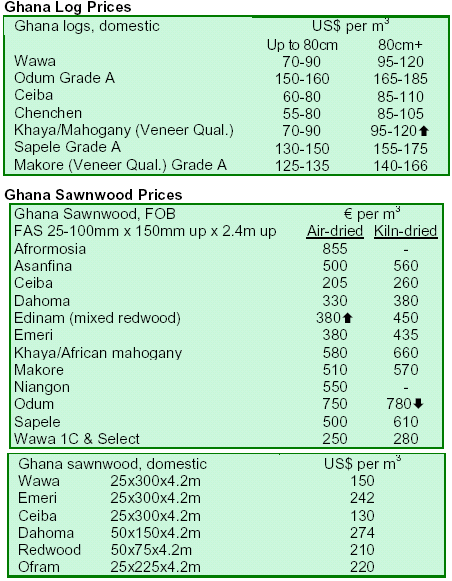
3.
MALAYSIA
Global mortgage crunch hits Malaysian prices
In a continuing trend from late July, most Malaysian timber prices (TTM 12:14) further weakened,
with the exception of logs. With the subprime mortgage market in steep decline and the tightening
of mortgage loans in the US, prices of furniture and furniture parts retreated, albeit
marginally. Prices of sawn timber were mixed even with steady demands from China and the Middle East.
However, India was a hard sell as commodity prices, including timber, declined broadly there over
the last few weeks. Prices of plywood and panel products might be adversely affected in the near
future should Japanese financial markets be impacted further by global credit
related issues, adding to current problems with excess supply. Additionally, Malaysian financial institutions had
been gradually tightening their credit, leaving timber exporters in need of working capital for their sawn
timber operations in a lurch.
Timber retains an important role in Sarawak¡¯s development
The Daily Express reported that the timber industry of Sarawak contributed about RM9 million in
export revenue in 2006, an increase of 24.4 from 2005, which contributed to the socio-economic
development of Sarawak. The Sarawak Timber Industry Development Corp. General
Manager, Datu Len Talif Salleh, said wood products like plywood, medium density
fibreboard, particleboard, blockboard and laminated boards constituted the bulk of
the exports, making up RM5.67 billion or 63% of total exports. He attributed the rise in exports to innovative
marketing strategy of the industry and its ability to meet buyer specifications.
Malaysia steps up replanting of logged forests
Deputy Director General of the Planning and Development of Forests of the Forestry Department,
Peninsular Malaysia, Datuk Dahlan Taha said the Department would replant about 25,000 hectares
each year in areas logged nationwide for timber. In total, the Malaysian government
plans to replant 300,000 hectares of forests cleared for timber over the next ten years, said The Star Online. A
total of 36,000 hectares had already been identified for logging under the Ninth Malaysia Plan. The size
of forests allowed for logging activity had been reduced drastically over the years and a nationwide
replanting programme had been progressively implemented over the years.
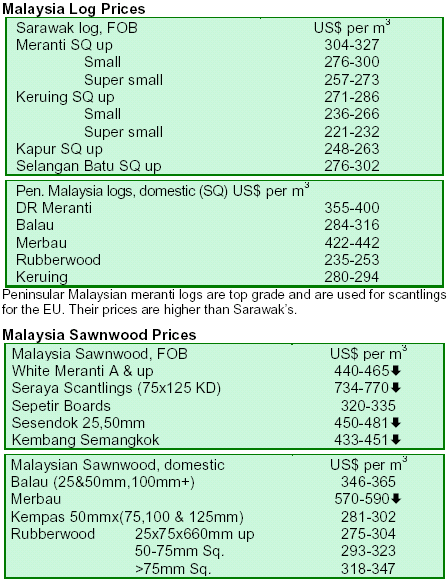
4.
INDONESIA
Slash and burn activities undermine Indonesian prices
Prices of Indonesian timber products remained adrift as the slash and burn activities intensified,
flooding the local market with cheap timber. As mentioned in previous TTM reports (see TTM 11:14),
this has made it difficult to differentiate between legal and illegally harvested timber
in the market. A widespread drought has also contributed to the problem as it provided easier access to forests and
forest plantations.
Japan and Indonesia to sign bilateral FTA
As reported by Kyodo news agency, Japan and Indonesia will sign a bilateral free trade agreement
(FTA) on 20 August 2007, during Prime Minister Shinzo Abe¡¯s visit to Jakarta. The agreement is
expected to come into effect early next year. Under the FTA, about 96% of Japanese
exports to Indonesia will become tariff-free, while about 93% of Indonesian exports to Japan in value terms will
be exempt from duties. In addition, Japan will immediately remove tariffs on Indonesian forest
products.
Papua seeks payment for forest conservation
The Wall Street Journal Online covered developments in Papua, Indonesia, where a proposal has
been floated to engage Papua in the world¡¯s emerging carbon market. The governor of Papua
proposed that companies could pay to conserve portions of land, and investors would then be
issued carbon credits to be traded in the European or other international carbon markets. The
conservation projects under this scheme could be a part of the World Bank¡¯s
larger work on ¡®avoided deforestation¡¯, and would attract investors wanting to enter into unregulated voluntary
markets for carbon trading.
Indonesia on verge of being top palm oil producer
Mongabay.com and Planet Ark report that Indonesia is set to take over from Malaysia as the
world¡¯s top palm oil producer this year, due to rapid expansion of palm oil
plantations over the last five years. Indonesia expects palm oil output to grow sharply over the next two years but
stricter forest protection may slow expansion somewhat. Palm oil producers have asked federal government
authorities in Jakarta to clearly define forest areas that need conserving.
Environmental groups have expressed concerns that rapidly expanding palm oil plantations, partly
due to ambitious biofuel plans, will damage rainforests and drive out rare wildlife species. Indonesia,
which currently has six million hectares of palm oil plantations, may however
restrict expansion despite record high crude palm oil prices. Nevertheless, the expanding palm oil industry will
increasingly provide the much needed raw material for the manufacture of panel products, e.g. MDF
for both exports and the local furniture industry, in the form of palm fibers.
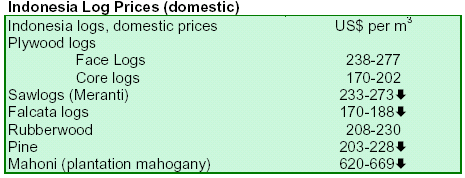
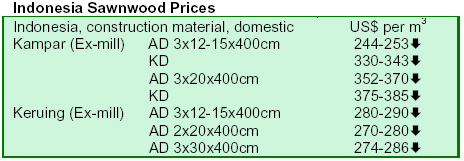
5.
MYANMAR
MTE prices fixed at high level
On 25 July, the Myanmar Timber Enterprise (MTE) fixed the latest raw material prices for the local
wood industry. The comparative prices shown in the chart below are the result of an 8-28% increase
on the 2007 March list prices. The prices are valid for logs used in local processing only,
and reveal the large gap between fixed prices and the monthly average price. This large disparity could once
again influence MTE to short-supply the local industry and sell more in log form at six months¡¯
average prices.
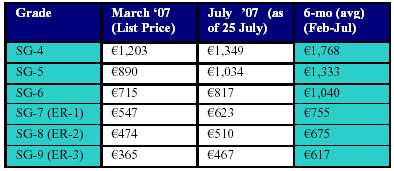
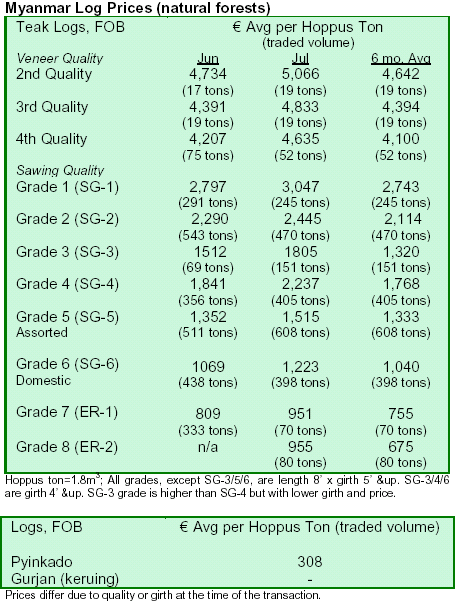
6. BRAZIL
Brazil sets to launch Annual Forest Grant Plan
The Brazilian Forest Service (SFB) is about to launch the final version of the first Annual Forest
Grant Plan (PAOF), which will make available about one million hectares of public natural forests for
harvesting using a bidding process for the concession. Folha da Mata said that the Plan, which was
open for public consultation, defines the area designated as public forests under
concession and outlines the procedure to obtain such a grant. Indigenous land, conservation units under full
protection, military areas, extractive reserves, settlements, and sustainable development reserves
are excluded from this grant.
The Plan aims to: clarify managed forest designated as public land (federal, state and municipal
domains); create the Brazilian Forest Service as a regulatory agency of public forest management
and facilitating agency of sustainable forest activities in Brazil; and create the
National Fund for Forest Development, which would focus on technological development, technical assistance
and sustainable forest development. The preliminary plan was discussed in late July during a meeting
attended by representatives of the productive sector, the National Forum of the Forest-Based
Activities and the Environment Council of the Federation of Industries (FIEPA) in the
state of Par¨¢. In August and September, criteria will be discussed and determined for the selection of companies
that qualify for the grant¡¯s bidding process.
Illegal logs fuel energy for Amazon steel industry
Madiera Total reported the results of a study conducted by the Council of High Amazonian Studies
of the University of Para, which showed that non-authorized deforestation supplied 57.5% of
fuelwood for charcoal production of the pig-iron and steel companies located in the states of
Par¨¢ and Maranhao. The research tracks charcoal production since the late 1980s, when the first
companies were built in the region. Easy access to the cheap and abundant wood
biomass and high quality iron ore also influenced high consumption levels.
Initially, tax incentives and later the Constitutional Fund for the North Region (FNO), which provided
public financing, were introduced to attract companies to Amazonia. The pig-iron companies took
advantage of the logistics from the Caraj¨¢s Project and lower costs compared to production in
Brazil¡¯s Southeast region. According to the research, 80% of the pig-iron produced
in the region was exported to North America.
The production of 3.5 million tons of charcoal, consumed by the Brazilian steel industry would
require 22.2 million m3 of fuelwood. This was higher than the volume authorized to be extracted in
the states of Par¨¢ and Maranhao (9.4 million m? as set by the Brazilian Institute
of Environment and Renewable Natural Resources (IBAMA). Besides severe fines already charged, IBAMA
sued four steel companies with criminal actions in July, charging BRL 832 million in indemnities. In
accordance with the Forest Code, a company that produces charcoal is mandated to have its own
forest to guarantee sustainable log harvesting. To guarantee payment of the fine, IBAMA
has requested the blockade of the steel companies¡¯ assets and asked the Federal Public Ministry and the Government
of Par¨¢ to take action.
Small sawmills on the brink of bankruptcy
According to the Gazeta do Povo, sawmills and other solidwood companies in the state of Paran¨¢
have faced serious difficulties to remain in the market. In the last three years, revenues have been
affected by the falling US dollar and plywood prices in the international market. As
many companies do not own forests, they face increasing log prices. Estimates show that pine log prices have
increased over 300% since 2000. Small and medium-sized companies that do not have a solid and
planned forest base have serious difficulties buying logs and many are shutting
down, according to the Department of Forest Plantations of the Secretariat of Agricultural and Supply (SEAB). The
Paran¨¢ Association of Forest Based Companies (APRE), which represented about 300 companies
and 170,000 workers, pointed out that in the last three years, 30,000 jobs were lost.
Since the sector was for a long time oriented toward the international market, the sector now faces
a problem of decreasing exports. According to the Ministry of Development, the revenue of Paran¨¢
forest companies was USD 496 million in the first quarter of 2007. Losses are
even bigger in Brazilian reals since the US dollar fell more than 30% during the period. Retraction from the
international market caused the wood shortage to become less serious. If the US dollar had
remained at BRL 3.00/USD (currently it is slightly below 2.00/USD) and the price of plywood had
not fallen, APRE estimates indicated little pine plantation would be left.
Par¨¢¡¯s solidwood exports reach USD 447 million
From January to July 2007, sawmills in the state of Par¨¢ exported a total of USD446.8 million, in
comparison to 2006, when total exports were USD647 million. The rise in the total value of exports
occurred with only 28 forest management projects authorized by the Secretariat of
Science, Technology and the Environment (SECTAM) said Fornecedores do Par? However, the exported
products were composed of accumulated stocks from the summer of 2006.
The sawmilling industry has a seasonal activity, and harvesting is carried out during the summer,
when storage is undertaken for the rainy winter season. The stocks from 2006 are about to be fully
depleted and the result of delayed approval of management plans will be felt at the
end of the year or in early 2008 (see also TTM 12:14). In addition to the delay in the authorization of management
plans, the decline of the US dollar was another obstacle to the export-oriented tropical lumber
sector. Such depreciation also stimulates competition with imported products resulting in workforce lay offs. According to the
Association of Wood Exporting Industries of the State of Par¨¢ (AIMEX), compensations are necessary for those
who lose on exports, including through tax reduction.

7. PERU
Study shows effectiveness of Peruvian policies on forest protection
Scientists at the Department of Global Ecology, Carnegie Institution, found that the Peruvian
government¡¯s policies to stop forest degradation and destruction resulted in only
1 to 2% loss of natural protected areas between 1999 and 2005. The findings, which were published in the 7 August
2007 edition of the Science Express, showed that the government¡¯s programme outlining the
justification for legal logging, protecting forests and establishing territories
for indigenous people helped keep natural forests relatively intact, reported
PhysOrg.com.
The study expressed concern over the rate of deforestation in the areas adjacent to logging
concessions and that the rate of forest disturbance was increasing in the last few
years of the study. PhysOrg.com noted that about 86% of the damaged forested areas were in the Madre de
Dios region and around Pucallpa, mostly near roads. The report indicated that the protected
forested areas were four times better protected than areas not set aside for conservation.
The methods for the study included the use of Carnegie Landsat Analysis System (CLAS), a high
special resolution satellite data system that detects forest damage, to analyze over 79% of Peru¡¯s
forested area. The scientists took into account timed policy events, such as the 2001
policy toplace 31% of Peru¡¯s managed forests under ¡®permanent resource production¡¯. The methods developed
for this study were previously tested in Brazil and are now being applied over Borneo. The Carnegie
Institution issued a statement highlighting the success of the CLAS system and hoped it would be
the standard for future analyses of rain forest disturbances and deforestation.
Peru and Mexico extend Economic Complementation Agreement
The governments of Peru and Mexico agreed to extend the validity of the Economic
Complementation Agreement (ECA), which was due to expire on 30 December 2007.
The decision to extend the ECA until 30 June 2008 was made in a meeting between the Peruvian Vice Minister of
Foreign Trade, Luis Alonso Garcia and the Mexican Sub-Secretary of International Commercial
Negotiations, Beatriz Leycegui. The agreement is significant to Peru-Mexico exports, since they
are increasing annually, with Peruvian wood products exports representing 26% of the total exports
for 2006, or US$5.7 million.
Peruvian exports find niche in EU market
During the first quarter of 2007, Peruvian exports to the EU increased by 17.4% compared to the
same period in 2006. The Management Office of Market Intelligence of the Peruvian Committee of
Promotion for Exports and Tourism (PROMPERU) reported that total exports reached
$2.17 million. Germany was the most important destination in the EU and 7th of all markets, followed by
Italy, Spain, and the Netherlands in the 9th, 10th, 11th positions, respectively. PROMPERU is gathering more
information about the EU market¡¯s characteristics, trends and opportunities, and requirements
for market access, in light of the EU¡¯s strategic importance for Peruvian exports.
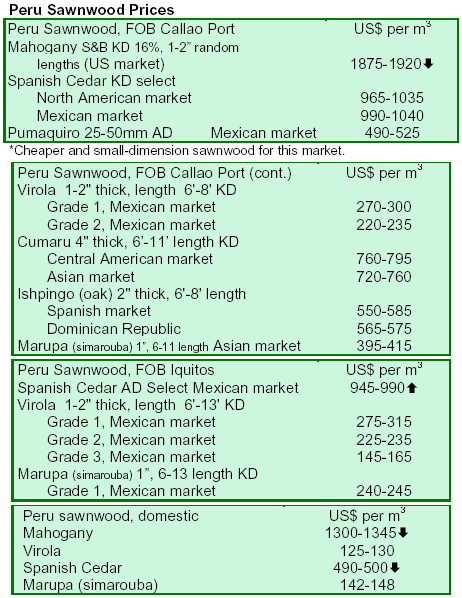
8. MEXICO
Coca-Cola in tripartite reforestation agreement in Mexico
The Twenty-five thousand hectares of ecosystems of high value will be reforested as part of an
agreement between the National Forest Agency (CONAFOR), the Coca-Cola Company, and
Pronatura. The area, which provides water to Mexico¡¯s main cities, would be reforested over the
next five years, and Coca Cola will provide six million dollars worth of funds to implement the
programme. As part of the initiative, an action plan would be made by Pronatura
Mexico with the support of CONAFOR, through its ProTree programme.
The President of Coca-Cola noted forests¡¯ contribution to a healthy water supply, and CONAFOR¡¯s
Director, Jose Cibrian, noted the positive impact the initiative would have on the country¡¯s forests
and water resources. Under the initiative, CONAFOR will support Pronatura to
identify the sites where reforestation activities will be undertaken, provide assistance for the definition of the
actions for the restoration of ecosystems and provide institutional support. CONAFOR will also purchase 30
million trees for use in the reforestation initiative.
9.
BOLIVIA
Bolivia¡¯s wood exports post strong and sustained growth
For the fifth year in a row, Bolivia¡¯s wood exports have shown growth in terms of volume and value.
Bolivian wood exports reached US$55 million during the first quarter, 24% above the same period in 2006. The US
continues to be the main market destination of products in terms of value, representing 35% of the total, compared to
44% last year. The UK has jumped from importing 1% to 9% of Bolivian wood products, and the Netherlands from
4% to 7%. China is Bolivia¡¯s second highest wood importer in terms of volume (13.5%), just behind the US (19.2%).

10.
GUYANA
Guyana gains more assistance for community forests
The government¡¯s programme to empower Amerindian communities through sustainable utilization
and development of forest resources is gaining further support from the international
community.Under the Sustainable Forestry Management and Hinterland Community
Development Project, two communities, Kwebanna and Batavia, will benefit from activities that seek to improve
forestry regulation and enforcement, and build capacity for sustainable management of the
communities¡¯ forest resources. The activities include the development of forest
management plans and annual operational plans and the provision of training and capacity building on key forested
areas. Assessment of the communities¡¯ forest resources will also be carried out.
The project, which targets Guyana and neighboring Suriname, will be undertaken through the World
Wildlife Fund (WWF), with a grant from the British Government. The agreement for the project was
signed by British High Commissioner to Guyana, Fraser Wheeler and Director of
WWF, Dominiek Plouvier, in the presence of the Minister of Agriculture Robert Persaud. Minister Persaud noted that
both Batavia and Kwebanna have tremendous potential for further community development and
utilization of their forest resources. The British High Commissioner said that
the current programme supports the work done over the years by the British Government to help develop Guyana¡¯s
forestry sector, and emphasized the contribution of the programme towards mitigating the effects of climate
change and preserving biodiversity.
Guyana puts focus on LUS and LVS
TTJ reported on ongoing work of the Guyana Forestry Commission and the Forest Products
Marketing Council ofGuyana to expand the country¡¯s inventory of timber species and ensure its
legality. These projects, funded in part by ITTO, involve testing the utility of lesser-used
species (LUS) by TRADA Technology and the development of a Legal Verification System (LVS) by the
UK¡¯s ProForest. Both projects will help UK consumers of tropical hardwood timbers (used in marine
construction) to ensure the resilience and legality of their product. The report noted that preliminary
outcomes on the project activities would be available in late autumn.
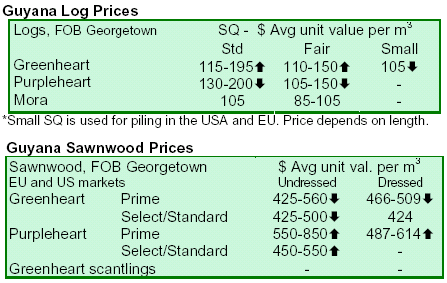
|